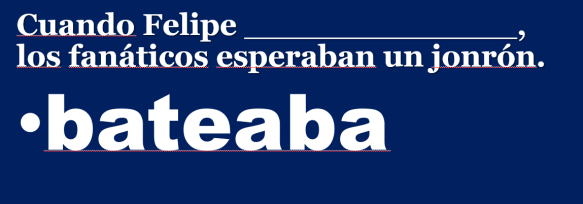I first heard the song Un millón como tú by Lasso (Venezuela) and Cami (Chile, Camila Gallardo) on February, 2. I immediately sent a message to Arianne Dowd, a fellow creator/collaborator who also likes Lasso. She responded immediately suggesting that she might use it with the novel Vida y Muerte en la MS 13. Brilliant idea! And…..oh no!! I’m going to add MORE music to this novel! (see these posts! and this one, too). I can’t help myself! The novel has been a favorite with my Spanish IV for the past 5 years, consistently being cited on end of the year evaluations as one they will remember, one that impacted them, and one in which the music was loved. And now, there is this absolutely perfect song for expressing how Analía’s family and Los Salvatruchas felt about their relationship (with a little imagination). The song has been an absolute HIT with my students, many of them singing it by heart! Combined with No hay nadie más by Sebastián Yatra, they create the perfect background for chapters 6 – 8 in the novel.
Step 1
I felt like my students needed to make some vocabulary/phrase connections. So, I targeted specific lyrics, found images to represent them and had students match the lyrics to the images as they read through the lyrics. 
Step 2
A. Find lyrics from the song that will support these lines from the novel:
A veces era un poco difícil estar juntos porque teníamos que salir a escondidas. Nadie estaba de acuerdo con nuestra relación, ni la familia de ella ni la mía, los Salvatruchas.
Sample answers: Y mis amigos me dicen que buena noticia que ya tú no estás
Dicen que ya no te llame; Todos opinan igual , Serás fácil de olvidar; y mis amigas
celebran felices que ya tú no estás
B. Find text from the novel to support this lyric from the song:
Debe ser que tú al final, si eras muy especial
(Additionally, the above text/lyric support activities actually complement English Language Arts standards for writing in grades 11 – 12!)
Step 3
Listen to the song and complete traditional cloze 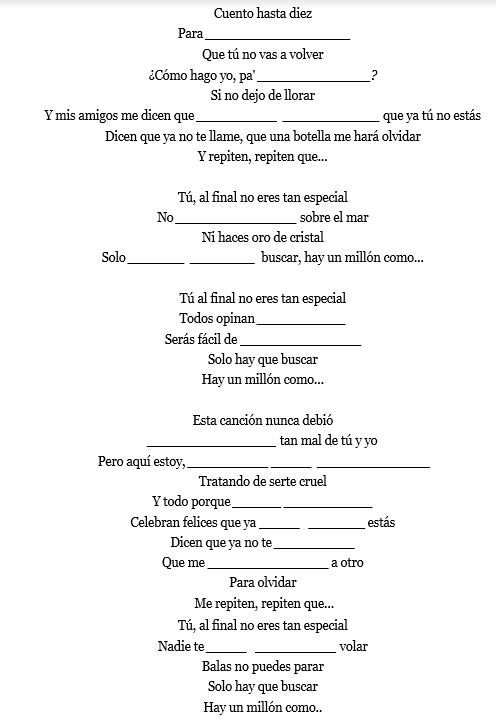
Read through the lyrics in English, then sing this much of the song. We then read through the remainder of the lyrics, where, after questioning why he/she can’t sleep, eat, etc. the opposite is declared: Tú al final sí eras muy especial and Tú al final eras el más especial. My angst driven teens just loved it! What a connection was made when they realized the twist in this love song AND when they began to realize, or question, that something is going to happen in the next chapters just as tumultuous with our narrator and Analía.
Step 4
Create a conversation:
Elige una:
- Toma el papel (role) del narrador y escribe una conversación entre sus compañeros o Pedro. Usa letras espécificas de la canción. Usa también tu imaginación y otras palabras.
- Toma el papel (role) de Analía y escribe una conversación entre sus compañeras o abuela. Usa letras espécificas de la canción. Usa también tu imaginación y otras palabras.
Usa tu propia papel. Por lo menos 8 líneas.
Of course, this song would be appropriate in many different situations, not just in this novel. The video is completely appropriate, the lyrics are comprehensible, the melody is memorable, and the song is absolutely “singable”.
Today I read how Andrés Vicente Lazo Uslar, known as Lasso, did, in reality, break up with his girlfriend, of 7 years, Sheryl Rubio, in September 2018. There has been great drama, with much of it played out on Twitter. See this article, and this one, and finally, this one. This could add another dimension to the song!
I’d love to hear from you if you use the song or create additional activities!

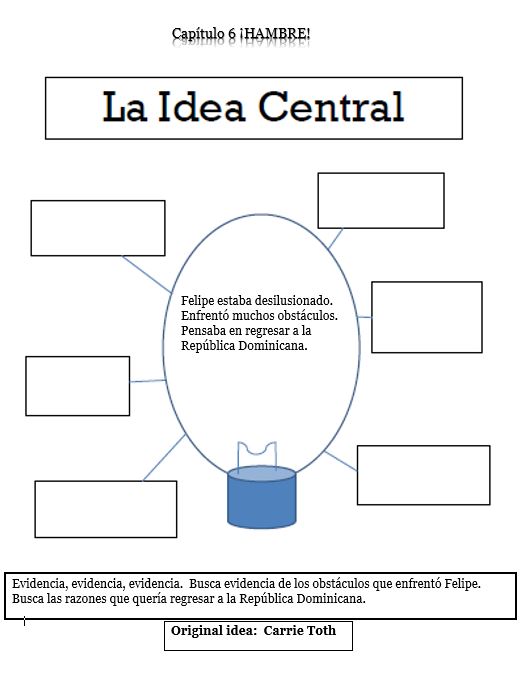


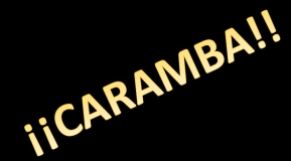


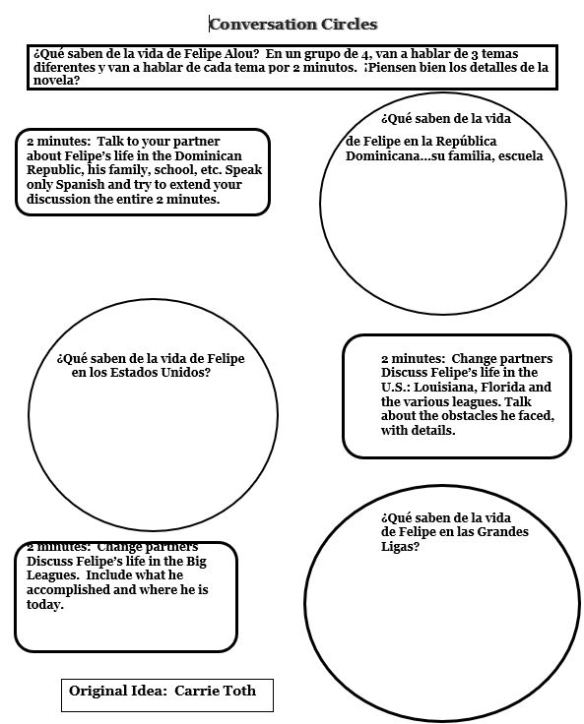









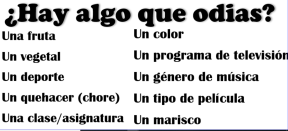
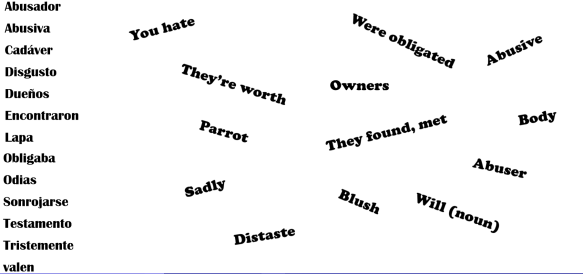
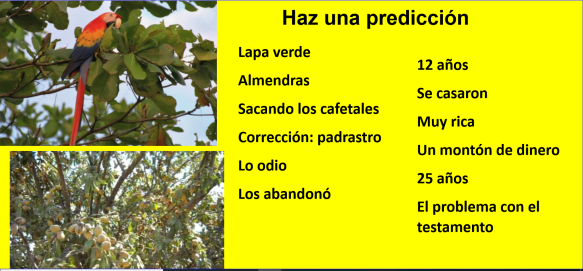


 It’s the end of the year. We’re still in school! The days seem endless and the students are not very motivated. What to do? Fall back on the one thing that has connected us from the very beginning: music! When I start thinking about how much music my Spanish IV students (who have had me for 2 years) have been exposed to, it’s a bit overwhelming. They LOVE music. There is no other way to put it. Even the most hardened, most resistant, most determined to not like anything student has connected with some song. I really don’t know how many of my students maintain Spanish playlists that they listen to on their own time, but it is a lot! They love being able to rush to me on Mondays and ask me if I have heard the latest from…. Sometimes they discover new songs before I do! So, I decided that I would try a version of a game that I loved a long time ago: Name That Tune! Of course, I have modified it for my purposes and it probably doesn’t resemble the original very much. Additionally, if I had more time (and more motivation), I could have made it a lot better and added categories for specific items (sports, individual artists, individual countries, individual genres, etc.). However, I didn’t (and don’t), so I’m going to give this format a try. If you’d like to try it, I’d love to hear from you. If you have the time/initiative and you add to it, please let me know.
It’s the end of the year. We’re still in school! The days seem endless and the students are not very motivated. What to do? Fall back on the one thing that has connected us from the very beginning: music! When I start thinking about how much music my Spanish IV students (who have had me for 2 years) have been exposed to, it’s a bit overwhelming. They LOVE music. There is no other way to put it. Even the most hardened, most resistant, most determined to not like anything student has connected with some song. I really don’t know how many of my students maintain Spanish playlists that they listen to on their own time, but it is a lot! They love being able to rush to me on Mondays and ask me if I have heard the latest from…. Sometimes they discover new songs before I do! So, I decided that I would try a version of a game that I loved a long time ago: Name That Tune! Of course, I have modified it for my purposes and it probably doesn’t resemble the original very much. Additionally, if I had more time (and more motivation), I could have made it a lot better and added categories for specific items (sports, individual artists, individual countries, individual genres, etc.). However, I didn’t (and don’t), so I’m going to give this format a try. If you’d like to try it, I’d love to hear from you. If you have the time/initiative and you add to it, please let me know.


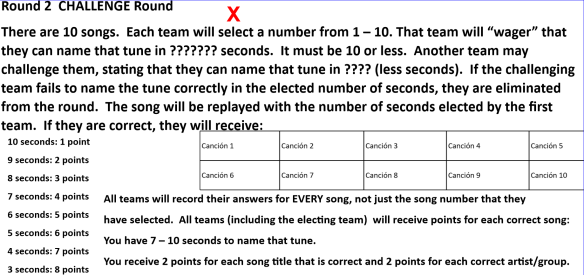




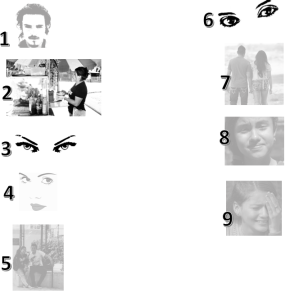




 I followed it with this slide:
I followed it with this slide:  We then did some brainstorming as a class, using this slide:
We then did some brainstorming as a class, using this slide:  The next day I put them in groups of three and gave each group a large baggie that contained the three time periods (antes de, en el medio de and después de) and many events for each category. Their task was to sort the events into the time period they thought they belonged. I will not lie, this was difficult for them, and after about 7 minutes we regrouped and talked about what we had for before or after. Several days later, we tried it again with more success. I strongly feel that it was beneficial, but that, of course, is just my opinion.
The next day I put them in groups of three and gave each group a large baggie that contained the three time periods (antes de, en el medio de and después de) and many events for each category. Their task was to sort the events into the time period they thought they belonged. I will not lie, this was difficult for them, and after about 7 minutes we regrouped and talked about what we had for before or after. Several days later, we tried it again with more success. I strongly feel that it was beneficial, but that, of course, is just my opinion. 
